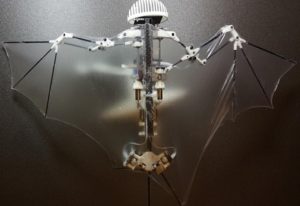
Researchers at the University of Illinois at Urbana-Champaign and Caltech have got success in developing an ultralight robotic bat – dubbed Bat Bot (B2) weighing just 93 grams – which can mimic the key flight mechanisms of a real biological bat.
Researchers have given this robotic bat soft, articulated wings to mimic morphological properties of flexible bat wings. This robot measures about 8 inches from head to tail. The most unique feature of the Bat Bot is its super-thin membrane that stretches to about a foot and a half.
“Our work demonstrates one of the most advanced designs to date of a self-contained flapping-winged aerial robot with bat morphology that is able to perform autonomous flight,” explains Alireza Ramezani, a postdoctoral researcher at the University of Illinois.
Ramezaniis is also the first author of the cover article, “A Biomimetic Robotic Platform to Study Flight Specializations of Bats,” that has been published in Science Robotics.
Ramezani developed the prototype with his advisors Soon-Jo Chung and Seth Hutchinson at Illinois. Chung is an associate professor of aerospace at Caltech and also a research scientist at the Jet Propulsion Laboratory, which is managed by Caltech for NASA. Hutchinson is a professor of electrical and computer engineering at Illinois.
To develop the Bat Bot, these researchers collaborated with Brown University professors Kenneth Breuer and Sharon Swartz, who have done extensive research on bat flight.
“Our work introduces a design scheme to mimic the key flight mechanisms of biological bats,” said Chung.
“There is no well-established methodology for reverse engineering the sophisticated locomotion of bats.”
The flight mechanism of bats involves more than three dozen types of joints to interlock bones and muscles to one another. This results in a musculoskeletal system can offer movement in multiple independent directions.
“The B2 possesses a number of practical advantages over other aerial robots, such as quadrotors,” said Chung.
“Bats do have more 40 active and passive joints; we reduced those numbers to 9 (5 active and 4 passive) joints in the B2 robot. The compliant wings of a bat-like flapping robot flapping at lower frequencies (7-10 Hz vs. 100-300 Hz of quadrotors) are inherently safe: because their wings comprise primarily flexible materials and are able to collide with one another, or with obstacles in their environment, with little or no damage.”
“Our flight control results are the first demonstration of using asymmetric wing folding of the main flexible wings to control the heading of the aerial robot,” Ramezani added.
“Its morphing property cannot be realized with conventional fabrics (such as nylon or mylar) that are primarily used in flapping wing research. Non-stretchable materials resist the forelimb and leg movements in B2. As a result, we covered the skeleton of our robot with a custom-made, ultra-thin (56 micron, silicone-based membrane that is designed to match the elastic properties of biological bats’ membranes.”
Hutchinson says a flapping of bat’s wings is like a rubber sheet.
“It fills up with air and deforms,” he said. “And then, at the end of its down-stroke motion, the wing pushes the air out when it springs back into place. So you get this big amplification of power that comes just from the fact you are using flexible membranes inside the wing itself.”
B2 can find its application in supervision of construction sites.
“Building construction projects are complicated, and rarely do they happen the way they are intended to happen,” Hutchinson said.
“Keeping track of whether the building is being put together the right way at the right time is not trivial. So the bat bots would fly around, pay attention, and compare the building information model to the actual building that’s being constructed.”
“For example, for tasks that require the aerial robots to be stationary, our bat-inspired aerial robots will eventually be able to perch, instead of hovering, by taking advantage of unique structures in construction sites such as steel frames, side walls, and ceiling frames,” Chung said.
“This is a more energy-efficient and reliable solution since stationary hovering is difficult for quadrotors in the presence of even mild wind—which is common for construction sites. Furthermore, perching or landing conventional aircraft and quadrotors in such unusual places is nearly impossible, due to their limited control authority at slow motor speeds and aerodynamic couplings such as wall or ground effects.”
“In addition to construction applications, we envision robotic flapping-wing robots operating in tight quarters with humans and beyond where humans can go,” Chung noted.
“B2 certainly cannot be used for lifting heavy packages yet, but a future version of Bat Bot could validate the benefits of soft-winged flight, such as improved energy efficiency and safety, for drone-enabled package delivery,” he said.
Hutchinson also thinks that B2 can be used for biological studies on bat flight.